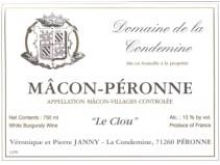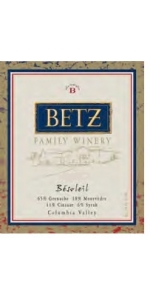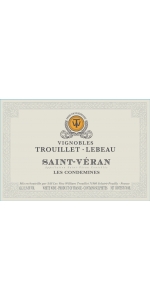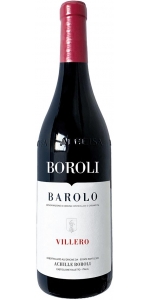Janny Condemine Macon-Peronne Le Clou 2015
| Country: | France |
| Regions: | Burgundy Maconnais |
| Winery: | Janny (Domaine de la Condemine) |
| Grape Type: | Chardonnay |
| Vintage: | 2015 |
| Bottle Size: | 750 ml |
All older vintage wines have been purchased from a single collectors cellar. Pictures can be requested before shipment.
Barolet-Pernot Auxey-Duresses Blanc Les Clous is 100% Chardonnay.
A very bright color with some green reflections. On the nose we find a fresh and elegant wine with aromas of fruit and wood.
On the palate we have a round wine with a beautiful freshness and minerality.
Domaine Barolet-Pernot Pere et Fils is a small Estate located in Saint Romain. They currently have 14 hectares (34 acres).
Blending Detail:
- 49 % Grenache
- 20% Syrah
- 16% Cinsault
- 9% Mourvêdre
- 6% Counoise
Grenache speaks loudly in the Bésoleil with notes of pomegranate, red raspberry, and strawberry leaf. The Counoise and Cinsualt bring bing cherry fruit and blueberry notes to the table, complicated by pepper and garrique. Mourvedre donates a wild meatiness to the blend, and a purple hue. Syrah rounds things out, adding texture, and flesh to the palate.
Review:
The first vintage where they’ve pushed the bottling back to give the cuvee 16-18 months in barrel, the 2015 Besoleil is a dead ringer for a high-quality Chateauneuf du Pape and offers perfumed notes of herbes de Provence, kirsch, licorice and sweet spice. It’s medium to full-bodied, textured and fruit-forward, with a hedonistic yet elegant profile that’s going to evolve gracefully.
Robert Parker 91-93 Points
Trouillet Lebeau St. Veran Les Condemines is made from 100 percent Chardonnay.
The wine comes from 70-year-old vines that are ideally located on a south-facing slope in the village of Leynes, on a clay-limestone terroir. Aged 100% in Burgundy barrels, offering a fruity, powerful and charming wine. Beautiful expressive aromas of ripe yellow fruits. Rich, generous, full, crisp and well-balanced on the palate.
Villero is undoubtedly one of the most important vineyards in Castiglione Falletto in terms of quality and exposure.
The soil is clayey and calcareous, with a south and southwest exposure. The combination of exposure and soil give us a structured and powerful Barolo, with a deep aromatic profile. The tannins are smooth and soft, thanks to long maceration.
Barolo Villero is a long-lasting wine, capable of reaching its full potential even many years after the harvest.
Wine Production
Villero is distinguished by a careful selection of grapes, perfect destemming, long macerations with submerged cap.
Tasting Notes
Clear bright ruby colour with very light garnet red reflections; intense and persistent aroma of red fruit with notes of plum and cherry. A pleasant aroma of wood is noticeable after the fruity aroma, anticipating the full taste of a great wine suitable for long lasting life. A succulent, rich, full-bodied and pleasant taste emerges after the woody one, with the presence of slightly ripe red fruit
Food Pairing
Thanks to its viscosity and body, Barolo is the ideal wine to combine with elaborate dishes such as truffle dishes, meat dishes, pasta with porcini mushrooms, game, and aged cheeses. Villero is also perfect with dry pastries or chocolate.
Review:
This Villero shows sterness and class at the same time. The nose is focused on cherrystone aromas, Parma violets, pomegranates and slightly earthy notes. The attack is dry and austere, with firm, dusty tannins soaked in licorice and tar, enhanced by a bright, juicy and polished blood-orange finish. This is a Barolo to discover over the years, even though it’s ready to drink now.
-James Suckling 95 Points
Condemine Janny Macon-Peronne Le Clou 2014 is made from 100% Chardonnay.
Sustainable agriculture: very low use of chemicals.
Very low amount of SO2 before bottling.
Wine is aged on the fine lees for a minimum of 4 months, which adds complexity and lenght to the finish.
A light golden hue, floral aromas. Intense, clean and fresh on the palate. Citrus notes, bold acidity. Excellent match to seafood with butter or cream sauces or rich blue cheeses
The Domaine de la Janny Estate
Pierre and Veronique Janny bought the estate in 1982 and work now with their daughter Celine. They are located in the village of Peronne, 20 kilometres North of Macon.
The Domaine de la Janny Vineyard
This is a 6-hectare (14.8 acres) vineyard planted with Chardonnay (5.5 ha), Gamay and Pinot Noir (0.5 ha). The oldest vines are 100 year old.
- back
Ghost Hull Cabernet Sauvignon is made of 100 percent Cabernet Sauvignon.
Aromas of blackberry, elderberry and ripe plum are accentuated by notes of mocha, fresh tarragon, vanilla and oak. The palate is full-bodied and offers a lovely balance of acidity and tannins accompanied by rich flavors of dark fruit and black currant, ending with a juicy and lingering finish
Boeira Douro Red is made from 35% Touriga Nacional, 35% Tinta Roriz and 30% Touriga Franca.
Deep ruby color with purple hints. Aromas of red and black fruits, toasty notes and dark chocolate. Smooth on the palate with good structure and excellent mouthfeel. Fresh, with well integrated tannins bringing elegance and a gastronomic profile to the wine. Very well balanced. Boeira Douro DOC Red from the Douro Valley is the result of a careful blend of different varieties from the Douro. After fermentation the wine was left in contact with its lees until bottling in order to develop complexity and richness.
Pair with pork roast stuffed with prunes and apricots, grilled meats, marinated leg of lamb, chicken curry, pasta with beef or pork ragout, vegetable timbale with roasted tomatoes and grilled almonds. A very “friendly” food wine.










